
Crown jewels
George Guidoni
Design & Innovation Sustainability Cans Case Packing Coding & Labeling Corrugated Palletizing Printing A-Arm Alliance Industrial Corporation Cousins Packaging Inc Crown Cork & Seal Dimac EBS Ink-Jet Systeme GmbH EBS-6200 Fat Tire Ferrum Gebo Cermex Krones AG Krones Volumetric VOC Linetec Solutions Inc. Multi-Color Corporation New Belgium Brewing Company Packaging Technologies Inc. (PTi) Pivot Systems Limited Regal Beloit Ryson Steam Whistle Brewing Steam Whistle Pilsner System Plast NGE Taxomatic Von Bugle Von Bugle MunichCanada’s premier craft brewer raises its packaging game to new heights with inline foil lid labeling capabilities for maximum shelf impact and pristine product purity
Blowing one’s horn may not seem like the epitome of modesty. But for the self-styled ‘Good Beer Folks’ at the Toronto-based Steam Whistle Brewing, the recent launch of the company’s new Von Bugle brand of Munich-style lager is a fittingly symbolic validation of 20 years of brewing and packaging excellence that have entrenched the hardworking beermaker firmly at the very top of Canada’s burgeoning craft beer business.
And getting there almost entirely on the strength of just one sole brand—the company’s signature flagship Steam Whistle Pilsner—makes that accomplishment seem all the more unique and satisfying for everyone taking part in this remarkable transformational journey.
Twenty years ago, Steam Whistle Brewing was just an idea without a home, started up by co-founders Cam Heaps and Greg Taylor around the premise of producing a single beer product, but doing it exceptionally well.
Upon finding home in downtown Toronto at a former locomotive repair facility called The Roundhouse, Stream Whistle founders proceeded to realize their vision with relentless drive, enthusiasm and dedication to the art and tradition of European brewing craftsmanship that quickly established their Czech-style pilsner as the rising star of Ontario’s then-fledgling craft-brewing scene.
And while the Steam Whistle Pilsner brand still remains the company’s most instantly recognizable calling card to this day, it may have to share some of its marketplace acclaim going forward with the newly-launched Von Bugle Munich Lager—produced and packaged at the company’s second new $19-million brewing facility located in the west-end Toronto suburb of Etobicoke.
Started up only a few months ago, the 55,000-square-foot brewery now houses all of the company’s canning and bottling operations—freeing up The Roundhouse site to concentrate on kegging, which accounts for a very respectable 30-percent share of Steam Whistle’s steadfastly growing output volumes.
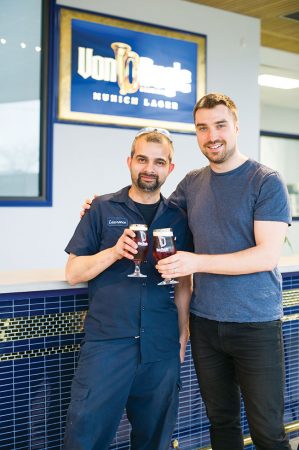
Packaging supervisor Lawrence Rench (left) and brand manager Jeff Deegan raising a toast with Steam Whistle Brewing’s new Von Bugle brand of Munich-style lager, which is currently shipped to LCBO (Liquor Control Board of Ontario) outlets and other Ontario-based retailers in pre-printed corrugated cases supplied to the company’s new 55,000-square-foot brewhouse in west-end Toronto by the brewer’s long-time packaging partner Packaging Technologies Inc. of Concord, Ont.
“We always knew that we were going to outgrow The Roundhouse one day, when would simply not be able to produce enough beer for nationwide distribution,” says Jeff Deegan, Steam Whistle’s brand manager for the Von Bugle label.
“So opening up a second facility was always in the cards,” Deegan told Canadian Packaging on a recent visit to the Evans Avenue brewhouse, a former print shop completely refurbished and modernized to house all the critical bottling and canning equipment once virtually fighting for open space at The Roundhouse facility’s confined quarters.
“And as the move to a new facility came closer to reality,” Deegan recalls, “we thought it would be a good idea to bring out a second beer brand at the new facility—something that would complement and live alongside Steam Whistle Pilsner, while staying true to our European lagering heritage.”
Because launching a second brand would mark a complete break with the company’s original ‘one beer company’ mantra, Steam Whistle spared no effort to ensure that the new brew would live up to the lofty standards and consumer expectations raised by stellar marketplace success of the original pilsner brand.
“We even brought back our former brewmaster Marek Mikunda out of retirement in his native Czech Republic to help us develop the new recipe and brand,” says Deegan.
“For the Von Bugle brand, we wanted to replicate the European tradition of producing a darker beer that would offer incredible full-body flavour, but would not sacrifice the drinkability and sessionability associated with traditional European lager,” Deegan says, calling the Van Bugle ‘the most sessionable dark beer’ in the Canadian market.
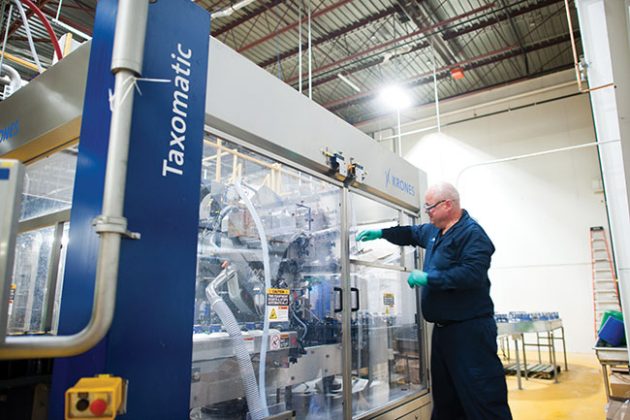
Packaging operator Brian Hann loading a new stack of foil lid labels inside the fully-automatic Krones Taxomatic machine installed at the new Von Bugle plant to apply pre-cut Purity Seal aluminum foil lids to all cans of the company’s canned products.
Distinguished with a beautiful rich amber color and a refreshing crispness associated with cold fermenting techniques, Von Bugle is made with a complex blend of traditional and grains and specialty hops—including the newly-bred Kazbek finishing hop sourced exclusively by Steam Whistle from the Czech Republic—to achieve a robust and bold taste profile that creates a smooth balance between gentle bitterness and malt sweetness.
Primarily targeting wheat Deegan calls “mature craft beer drinkers,” the new lager offers a “reliable flavorful beer that is also drinkable and easy-going enough to be enjoyed over the length of a sporting event on TV or the course of a summer barbecue,” Deegan opines.
As for the brand name, Steam Whistle borrowed a page from its own playbook by associating it with the loud sounds generated by a bugle horn to signal the start of finish of a workday or other scheduled activities—much in the same way that stem whistles were used back in the golden age of steam-powered rail locomotives.
“The bugle would have been one of the earliest musical instruments the early European settlers would have brought with them to Canada,” Deegan explains.
“It would have been widely used to bring the local community together for special events and celebrations,” he says, “and so it made a very suitable point of reference to our company’s nod to the European brewing heritage.”
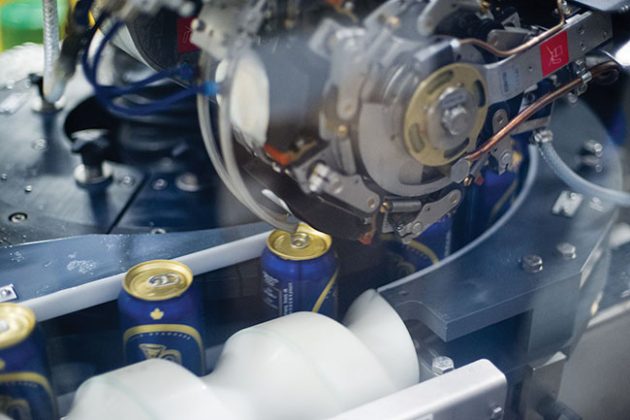
The high-speed Taxomatic foil lid applicator utilizes a high-precision starwheel to apply and crimp pre-printed Purity Seal foil lid labels onto the passing cans of beer at a robust throughput speed of 225 cans per minute
And while the new beer’s elaborate, regal blue-and-gold brand graphics represent a colorful departure from the more laid-back green-and-white color palette used to market the pilsner product, the two beers share a unique branding and packaging commonality buy virtue of having the cans of both brands being topped off with an additional thin layer of branded foil lidding—applied onto the can ends inline just after seaming via the brand new Taxomatic lid labeling machine installed at the new facility’s canning line earlier this year.
Manufactured in Germany by Krones AG, the Taxomatic machine was integrated into the plant’s Krones Volumetric VOC can filling line, combined with a Ferrum seamer, to top off the 473-ml direct-printed aluminum cans with pre-cut foils that serve as an added layer of hygienic protection for the lids, while providing another layer of packaging real estate to advertise and market the brand.
Mounted vertically above the infeed starwheel, the Taxomatic labeling station transfers the pre-cut round foils onto the passing containers from above, which are automatically cold-glued and pressed into place at a blink of an eye with unerring precision and repeatability at a brisk pace of 225 cans per minute.
Said to be the first Krones Taxomatic machine to be installed at any brewery in Canada, the half-million-dollar system is quickly proving to have been worth every penny in terms of immediate shelf impact and rand differentiation, according to Deegan.
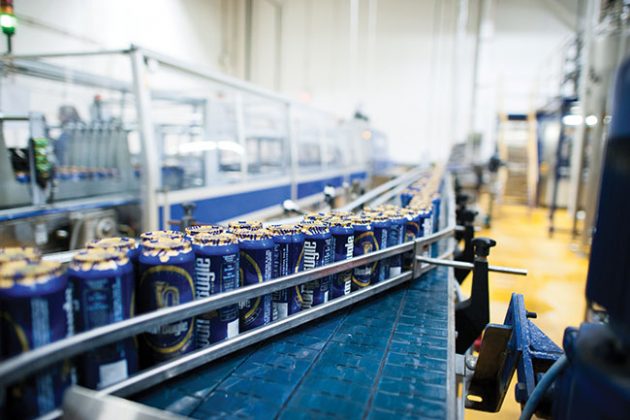
The Von Bugle plant makes extensive use of high-performance SEW-Eurodrive motors to achieve optimal power distribution for the plant’s conveyor lines,including this signature-blue System Plast NGE belting, guide rails and brackets manufactured by Regal Beloit Corporation.
“We take a lot of effort in producing a pure product free of additives, corn syrup, artificial foam enhancers and so on,” Deegan says, “and having this foiling capability helps us ensure tat the consumer holding this beer in their hands will have the purest beer experience possible.
“A lot of people who have tried our foil-lidded beer have told me that they now think about it every time they see a ‘naked’ can of beer, and make sure that they give it a wipe before opening.
“The truth is that once the cans of beer leave the warehouse, there is no telling what they my have gone through before ending up on the store-shelf,” Deegan points out, “so this layer of foil gives consumers a real peace-of-mind, as well as another good reason to choose our product.”
Deegan adds he’s also very happy about the subtle subliminal brand connection made at the shelf level between the two brands despite the considerable differences in the graphic designs featured on the canned products.
The packaging graphics for both of the company’s brands were created by Steam Whistle’s talented in-house graphic designers, including the logo graphics for the fully-recyclable pre-cut foils printed in Germany by Multi-Color Corporation and shipped to the plant in ready-to-load stacks to be inserted into the Taxomatic unit’s magazine.
The application process uses specially-formulated glue, also supplied by Krones, to make the labels adhere to the cans’ surface area to cover the top and a bit around the sides, after which the foil is crimped into place to remain sealed right up to the moment of consumption, with consumer simply pulling on a little tab on the label’s edge for quick and easy removal.
According to Steam Whistle’s national planning and procurement manager Glenn Truelove, integrating this extra packaging step into the process has had no adverse impact of the production line’s speeds whatsoever.
“We did not need to compromise any line efficiencies to accommodate this new value-added capability,” says Truelove, praising Krones for coming up with a perfect solution to Steam Whistle’s insistence on 100-percent recyclability of all its packaging.
“The glue supplied by Krones is actually a vegan formulation that does not impede recyclability at all,” Truelove relates.
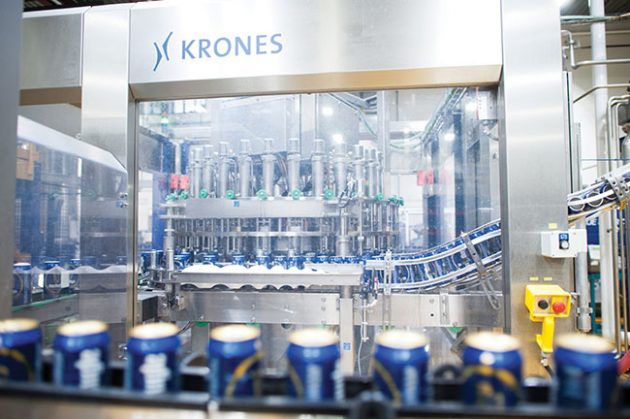
Mostly comprised of high-performance equipment manufactured by leading German beverage processing and packaging systems group Krones AG, the highly automated canning line typically requires only eight operators to oversee the smooth-running packaging process.
As for the extra costs of the so-called Purity Seal materials, Truelove says they are virtually negligible—adding up to less than the costs of applying a standard paper label.
“It’s a wonderful billboard for our new product,” Truelove extols, “whereby the sparkling gold background with blue lettering and logo creates incredible shelf presence.”
According to Truelove, the new facility currently has annual capacity to produce 85,000 hectoliters of Steam Whistle Pilsner and 3,000-hectoliters of Von Bugle—for now distributed only in Ontario—as well as accommodate co-packing requirements for the Fat Tire beer band of New Belgium Brewing Company, a Colorado-based beermaker ranking as the fourth-largest craft beer producer in the U.S.
With canned beer nowadays accounting for about 40 per cent of the company’s output volumes, the Von Bugle plant makes extensive use of its fully-automatic bulk depalletizer—manufactured by Alliance Industrial Corporation—to unload the endless stream of towering palletloads of direct-printed aluminum cans supplied to the plant by a Crown Cork & Seal plant in Batesville, Miss.
The unloaded cans are quickly transferred towards the canning line along a highly synchronized network of food-grade conveyors—including System Plast NGE belting from Regal Beloit and product transfer conveyors from Gebo Cermex—to pass through strategically positioned Krones rinsing, drying and UV light-curing stations, before entering the Volumetric VOC filler in a single file for high-precision filling and seaming.
After the filling process is done and the Purity Seal foil lids are applied, the cans are date-coded by a small-character EBS-6200 inkjet printer—manufactured in Germany by
EBS Ink-Jet Systeme GmbH—and conveyed down the line for case-packing.
Upon entering the Dimac Blue Star case-packer, the cans are grouped into four- or six-packs, which are immediately heat-sealed in plastic stretch film, or loaded 24 at a time inside pre-printed corrugated trays—supplied by the brewer’s long-time packaging partner Packaging Technologies Inc. (PTi) of Concord, Ont.—to be sold as individual single-serve cans.
From there, the finished packs make their way onto a Ryson vertical spiral conveyor to be moved inside the fully-automatic Columbia HL2000 palletizer, which stacks them
onto the shipping pallets seven-layers-high.
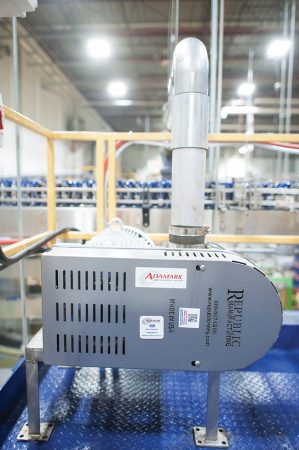
The canning line’s drying station features the Adamark air-knife system from Republic Manufacturing, distributed in Canada by R.E.Morrison Equipment, to make sure all the rinsed beer cans are completely dry before entering the line’s filling and capping system.
Once done, the palletized loads are whisked by forklift to the semi-automatic model A-Arm turntable stretchwrapping machine—manufactured by Cousins Packaging Inc.—which applies a layer of protective stretchwrap film around the load.
The stretchwrapped loads are then swiftly moved inside the plant’s onsite cooler warehouse to await customer delivery, which is primarily handled via the brewer’s own fleet of delivery trucks and vehicles decorated with large-format Steam Whistle or Von Bugle brand graphics.
The highly automated canning line process typically requires only eight people per shift to operate from start to finish, according to Truelove, who is quick to compliment Krones for the quality and reliability of its equipment, as well as unfailing customer service.
“The Taxomatic machine, for example, took just one day to install, a couple of more days to all the wiring hookups, and then we were ready to go,” says Truelove, noting that the user-friendly system has not experienced any unscheduled downtime since then.
To give credit where it’s due, Truelove is also highly complimentary about the machine installation work for most of the plant’s equipment performed by Toronto-based Pivot Systems Limited, along with the line design expertise provided by Linetec Solutions Inc. of Mississauga, Ont.
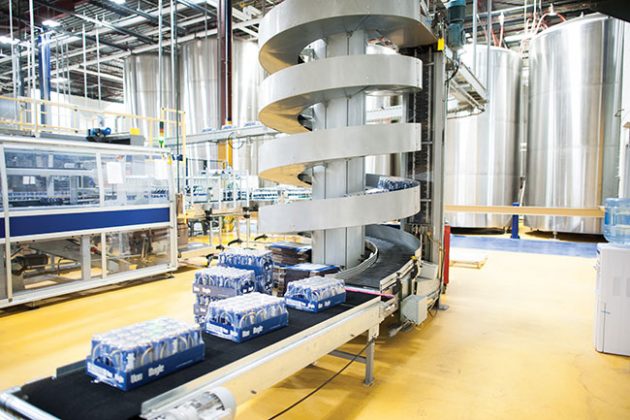
A spiral conveyor manufactured by Ryson International gently transferring the finished trays of cans of the new Von Bugle brand of beer upwards in the direction of a fully-automatic palletizing system for stacking the trays onto shipping pallets for storage and distribution.
“We are getting about 75-percent line efficiency in our canning operations right now,” Truelove relates, “which is pretty good in this industry.
“I would like to see it closer to 80 per cent,” he adds, “but I am sure we will get there by the end of the year.
“Being Canada’s Number One craft brewer means everyone else is out to catch up to you,” Truelove concludes, “but with the new facility and an exciting new product in place, we are more than ready for whatever the future holds.”
Advertisement

